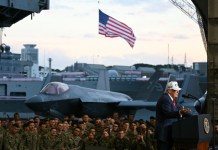The US Navy is set to receive Tomahawk Block-V missiles next week. This is the latest and the most advanced member of the subsonic BGM-109 cruise missile family developed by Raytheon.
Analysts, however, question the US’ continued dependence on subsonic missiles when its adversaries, including Russia and China, are developing hypersonic weapons at breakneck speed.
Block Va and Vb configurations bring in additional capabilities to the missile’s mission profile, which includes hitting moving surface ships in excess of 1,000 miles away. The Block Va is the Maritime Strike Tomahawk (MST), which allows the missile to engage a moving target at sea, because of the addition of new sensor systems including a seeker kit.
The Block Vb is outfitted with the Joint Multiple Effects Warhead (JMEWS) for hard-target penetration, more oriented towards striking land targets.
One of the key advantages that the missile would offer to the US Navy is its cost and logistics. The Block-V Tomahawk can be launched from the standard Mk.41 VLS (vertical launch system) silo, the same silo that currently carries standard anti-air missiles, the SM-3 missile interceptor, Evolved SeaSparrow interceptor missiles, and vertical launch anti-submarine rockets.
This essentially means that the missile would not need additional launch infrastructure, saving a lot of hassle and training that would be required for any other missile. This also means that it can be outfitted with the Navy’s attack submarines, which can more easily operate inside the range of the Chinese PLA’s rocket force, according to Defence News.

Also, the Tomahawks are in service with the US Navy since 1983, requiring no additional operating procedures and training manuals. Another consideration is the cost, with each missile priced at around $1 million, which is still a low-end for cruise missiles of this category.
The development of the new missiles and their recent procurements by the US Air Force and the Navy – including the JASSM, LRASM, and the naval strike missile can also be attributed to the rapid modernization efforts by the Russian and the Chinese Navy.
With Beijing being the elephant in the room, the US is not fully aware of the PLA Navy’s expansion and its aggressive stance in the Indo-Pacific. In 2020, a congressional report also stated that the PLA Navy has surpassed the American Navy in terms of the number of surface ships in operation (however, tonnage favors the latter).
Major Concern
One major concern for the Tomahawk missile is its subsonic speed. As the world is moving forward towards supersonic and hypersonic missiles, the US hasn’t been able to catch up well with its adversaries. Russia and China have already inducted ship- and land-based hypersonic cruise missiles, while India has also successfully tested its hypersonic technology demonstrator vehicle (HSTDV) last year and already has a supersonic cruise missile in operation.
However, with Tomahawk being the US Navy’s primary attack cruise missile, it is susceptible to interception by many sophisticated air defense systems in service globally. Even in 2018, the Russian military said that Syrian air defenses shot down 71 of the 103 missiles launched by the US and its allies against Syrian targets near Damascus and Homs.
However, Bryan Clark, a retired submarine officer and senior fellow at The Hudson Institute, defended the missile’s viability. He explained, “Being sub-sonic means its also able to travel at a more fuel-efficient speed. So, the fact that the Tomahawk can travel more than 1,000 miles is a function of the sub-sonic speed. To get that kind of range out of a supersonic missile you’d need something much larger.”




